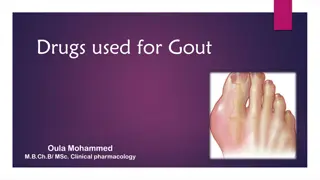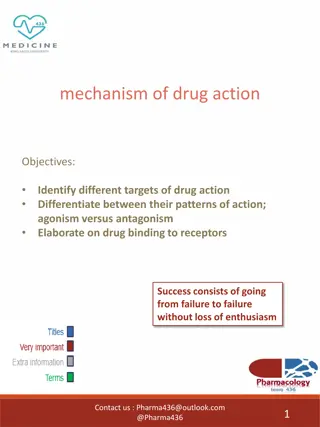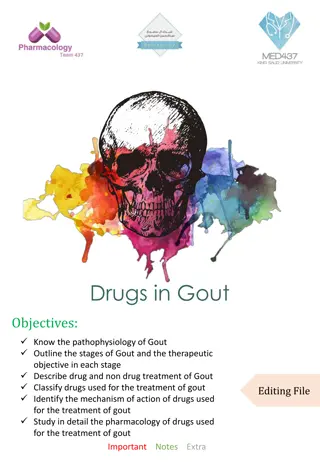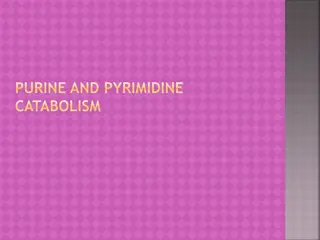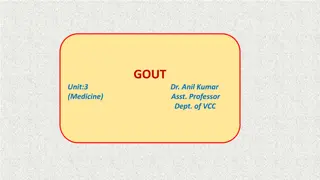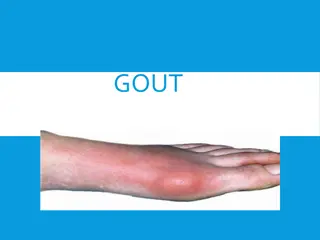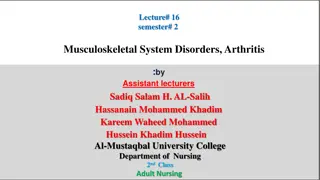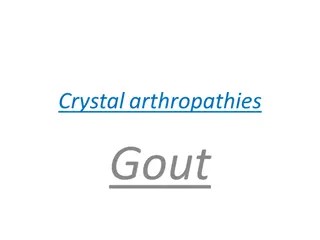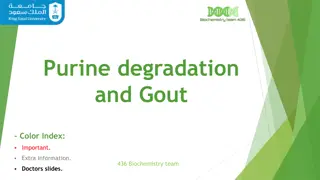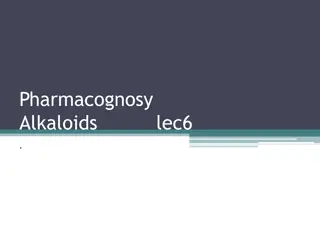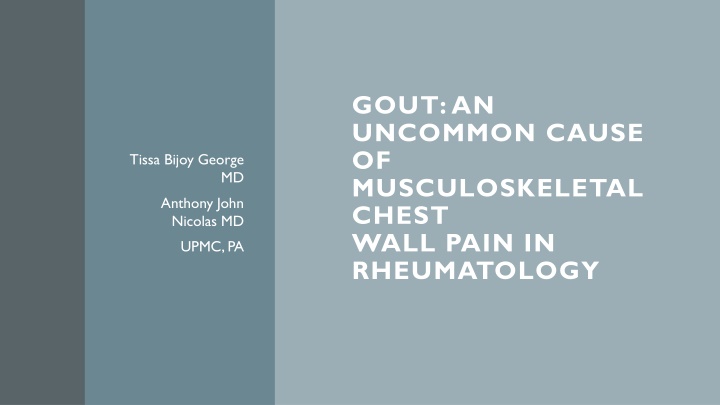
Uncommon Musculoskeletal Chest Pain in Rheumatology - Gout Case Study
A 59-year-old man with a history of hypertension and lung cancer presented with musculoskeletal chest pain managed for gout. The case includes details of his medical history, timeline of events, and musculoskeletal examination findings, highlighting the diagnosis and management of gout affecting the chest wall.
Download Presentation

Please find below an Image/Link to download the presentation.
The content on the website is provided AS IS for your information and personal use only. It may not be sold, licensed, or shared on other websites without obtaining consent from the author. If you encounter any issues during the download, it is possible that the publisher has removed the file from their server.
You are allowed to download the files provided on this website for personal or commercial use, subject to the condition that they are used lawfully. All files are the property of their respective owners.
The content on the website is provided AS IS for your information and personal use only. It may not be sold, licensed, or shared on other websites without obtaining consent from the author.
E N D
Presentation Transcript
GOUT: AN UNCOMMON CAUSE OF MUSCULOSKELETAL CHEST WALL PAIN IN RHEUMATOLOGY Tissa Bijoy George MD Anthony John Nicolas MD UPMC, PA
59-year-old gentleman with medical history of hypertension, hyperlipidemia, metastatic non-small cell lung cancer,currently in remission on Lorlatininb presented to the rheumatology office to establish care for management of gout. CASE PRESENTATION
TIMELINE 3/2023: localized sternal pain, with a tender mass over upper sternum. Treated with a short course of prednisone (30mg taper over 10 days) One year history of intermittent monoarthritis of ankle or right first MTP every 2 to 3 months 4/2023: established care with rheumatology 2/2023: started on allopurinol 100mg daily by cardiology after a left ankle acute monoarthritis, hyperuricemia 3/2023: Ultrasound chest with evidence of degenerative findings at the manubriosternal joint
Past medical history: hypertension, hyperlipidemia, 6/2017 diagnosed with stage IV NSCLC metastatic abdominal lymph nodes (initially treated with alectinib, then lorlatinib, with negative surveillance pan CT every 6 months) HISTORIES Social history: never smoked, drinks alcohol socially, no recreational drug use
MUSCULOSKELETAL EXAM Tenderness over the manubriosternal joint with minimal underlying swelling No tophus No synovitis
ULTRASOUND EXAM Manubriosternal joint: one erosive change over the manubriosternal joint along with extensive osteoarticular degeneration. Bilateral ankles: no chondrocalcinosis or double contour sign Right 1st MTP: radiographic tophi. No double counter sign
Longitudinal view of manubriosternal joint erosions on Axial view of manubriosternal joint erosions on ultrasound. ultrasound.
DATE Uric acid mg/dL 2/2023 11.3 3/2023 9.5 3/2023 8.6 LABS 5/2023 6.9 6/2023 5.5 7/2023 5.0
Longitudinal view of manubriosternal joint erosions on Axial view of manubriosternal joint erosions on CT chest without contrast. CT chest without contrast.
With a history of episodic monoarthritis, podagra, hyperuricemia, we made a working diagnosis of gout. DIAGNOSIS Unfortunately, patient never had an arthrocentesis done for crystal analysis
CLINICAL COURSE In addition to up-titrating allopurinol to achieve a goal uric acid level of <5mg/dl for tophaceous gout, we started him on colchicine 0.6mg twice a day. He had no new acute episodes and colchicine was discontinued 6 months after achieving his goal uric acid of <5mg/dl, currently on allopurinol 400mg daily.
In rheumatology, SAPHO syndrome, rheumatoid arthritis, osteoarthritis, relapsing polychondritis, axial spondyloarthritis, and fibromyalgia are among the most common causes of chest wall pain (1). DISCUSSION
The manubriosternal joint is a secondary cartilaginous joint (symphysis) between the two parts of the sternum. A fibrocartilage disc exists between these two articular surfaces and ossifies with advancing age (2). DISCUSSION
Peripheral synovial joints are the common locations in gouty arthritis and involvement of the spine, sacroiliac joints, symphysis pubis, or thoracic wall is uncommon (3). DISCUSSION
A recent comprehensive literature review only includes 8 case reports published up until 2022 (4). DISCUSSION
DISCUSSION As in our case report, ultrasonography can be used as an excellent tool at the bedside in diagnosing gout. Ultrasound features include: general features like synovitis, tenosynovitis, subcutaneous edema and specific features like double contour sign, tophus, aggregates and erosions (5).
1. Winzenberg T, Jones G, Callisaya M. Musculoskeletal chest wall pain. Aust Fam Physician. 2015 Aug;44(8):540-4. PMID: 26510139. 2. MBBS, Shahab Shahid. Sternum. Kenhub, Kenhub, 11 Sept. 2023, www.kenhub.com/en/library/anatomy/sternum 3. Perez-Ruiz F, Calabozo M, Alonso-Ruiz A. Gouty arthritis in the manubriosternal joint. Ann Rheum Dis. 1997 Sep;56(9):571. doi: 10.1136/ard.56.9.571. PMID: 9370889; PMCID: PMC1752449 REFERENCES 4. Wang G, Luo Y, Li B, Wen Z, Li J. Involvement of anterior chest structures accompanied with chest pain in patients with gout. Arch Med Sci. 2023 Feb 22;19(2):532-535. doi: 10.5114/aoms/160005. PMID: 37034509; PMCID: PMC10074313 5. Christiansen SN, stergaard M, Terslev L. Ultrasonography in gout: utility in diagnosis and monitoring. Clin Exp Rheumatol. 2018 Sep- Oct;36 Suppl 114(5):61-67. Epub 2018 Oct 1. PMID: 30296983

![❤[PDF]⚡ Civil War Talks: Further Reminiscences of George S. Bernard and His Fel](/thumb/20551/pdf-civil-war-talks-further-reminiscences-of-george-s-bernard-and-his-fel.jpg)
![❤Book⚡[PDF]✔ Doing the Impossible: George E. Mueller and the Management of NASA’](/thumb/21684/book-pdf-doing-the-impossible-george-e-mueller-and-the-management-of-nasa.jpg)

